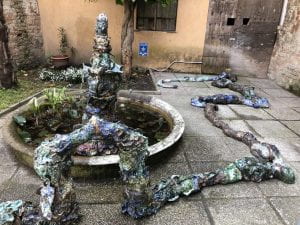Macao and Thailand
Apparition: The Macao Pavilion
The Macao Pavilion, featuring the works of artist Heidi Lau, is an exploration into the region’s identity, past and present. Lau is a Macao native who witnessed much of its transformation into a gambling capital with a growing sense of helplessness. In her eyes, the “Las Vegas of the East” that Macao has become does not reflect the centuries-old heritage buried beneath skyscrapers and casinos. Apparition, Macao’s contribution to the 58th Venice Biennale, highlights this disparity between what Macao was and what Macao has become.
Common visual themes in the Pavilion included the use of ceramic to create totemic, zoomorphic sculptures that evoke the history of Macao. Ten sculptures can be found throughout the exhibit, each assigned to one of four themes: Apparition I: Primitive Memories, Apparition II: The Ancestral House, The Contemporary Moment: Learning from Casino, and Reflective Nostalgia: The Old Recreation Garden. These themes provide a sense of logic and flow to the viewing experience.
You begin in the garden, where winding, animal-like sculptures perch near bubbling fountains. Like its “primordial” title, it calls to mind a time before politics. As you enter the indoor area, you are confronted with casino imagery that has been intentionally intertwined with cultural symbols. Lau remarks at how the two have been equated, elevated to equal levels of importance to the history of Macao. In the last area, she draws inspiration from Lou Lim Ieoc Garden, a national park in Macao, and looks towards a future where the region can truly belong to its natives again.
All in all, Lau created Apparition to grieve her home nation, which in a sense now exists only in her childhood memories. She raises important questions about the often non-consensual effects of colonization and globalization on a culture. That the exhibit was curated by another Macao native (Sio-man Lam) and sponsored by the Macao Special Administrative Region Government suggests that she is not alone in this perspective.
Perhaps she has taken the first steps toward undoing Macao’s dominant perception as the “Las Vegas of the East” by bringing this poignant exhibit into the global art sphere.
The Revolving World: The Thailand Pavilion
Thailand brought similar themes of changing identity and culture into the global conversation for the 58th Venice Biennale. Like Apparition, The Revolving World discusses colonialism and its impact on culture, only with a less somber tone—the darkened room of the exhibition is illuminated by flashing lights, toy-like sculptures, and an overall sense of whimsy.
Headed by three esteemed Thai artists (Somsak Chowtadapong, Panya Vijinthanasarn, and Krit Ngamsom) and curated by another (Tawatchai Somkong), this government-sponsored exhibit is essentially Thailand’s take on global pop culture. It takes the perspective that interculturalism is as inevitable as time, and different cultures give us different angles from which to view history. Instead of rejecting the role of pop culture, economic growth, and consumerism in contemporary Thai culture, the artists embrace it. Many of the works are colorful re-imaginings of traditional imagery—most notably, the Buddha—that, while Thai at their core, reflect changing and increasingly consumerist ideas of what it means to be Thai today.
As a whole, both the Macao and the Thailand Pavilions address the concept of losing their sense of control over the way that culture is played out in the global arena, with differing attitudes about it.
Good or bad, cultural interaction is inevitable—but what can or should be done about it? At the 58th Venice Biennale, you’ll find this question has no clear answer.
By Brooke Price

